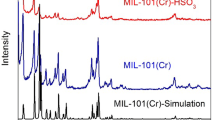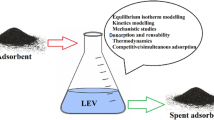Abstract
This work found that rectorite (REC) has a good adsorption effect on cationic pollutants such as ciprofloxacin (CIP), with a maximum adsorption capacity of 79.73 mg/g for CIP. The zeta potential analysis showed that the electronegativity of the REC surface would be weakened after CIP adsorption under acidic conditions. Through adsorption kinetics, isotherm study, XRD, FTIR, and other characterizations, the phenomenon of reduced negative charge on the surface of REC adsorbed with CIP under acidic conditions was explained. Based on the Langmuir and Temkin models, the adsorption process of CIP on REC is a spontaneous endothermic adsorption process. The adsorption kinetics can be better described using a pseudo-second-order model, indicating that the adsorption rate is mainly controlled by chemical adsorption. The characterization further proved that REC adsorbed ciprofloxacin mainly through hydrogen bonding, cation exchange, and electrostatic gravitational interaction. CIP, as an emerging contaminant discharged into the water environment, will be harmful to the ecological environment and human health. Therefore, the utilization of REC for the removal of CIP from an aqueous solution has potential prospects.







Similar content being viewed by others
Data availability
All data generated or analyzed during this study are included in this article.
References
Al-Ghouti, M. A., & Da’ana, D. A. (2020). Guidelines for the use and interpretation of adsorption isotherm models: A review. Journal of Hazardous Materials., 393, 122383. https://doi.org/10.1016/j.jhazmat.2020.122383
Antonelli, R., Malpass, G. R. P., da Silva, M. G. C., et al. (2020). Adsorption of ciprofloxacin onto thermally modified bentonite clay: Experimental design, characterization, and adsorbent regeneration. Journal of Environmental Chemical Engineering., 8(6), 104553. https://doi.org/10.1016/j.jece.2020.104553
Araújo, C. S. T., Almeida, I. L. S., Rezende, H. C., et al. (2018). Elucidation of mechanism involved in adsorption of Pb (II) onto lobeira fruit (Solanum lycocarpum) using Langmuir. Freundlich and Temkin Isotherms. Microchemical Journal., 137, 348–354. https://doi.org/10.1016/j.microc.2017.11.009
Azizian, S. (2004). Kinetic models of sorption: A theoretical analysis. Journal of Colloid and Interface Science., 276(1), 47–52. https://doi.org/10.1016/j.jcis.2004.03.048
Carabineiro, S. A. C., Thavorn-amornsri, T., Pereira, M. F. R., et al. (2012). Comparison between activated carbon, carbon xerogel and carbon nanotubes for the adsorption of the antibiotic ciprofloxacin. Catalysis Today., 186(1), 29–34. https://doi.org/10.1016/j.cattod.2011.08.020
Cetecioglu, Z., Ince, B., Gros, M., et al. (2013). Chronic impact of tetracycline on the biodegradation of an organic substrate mixture under anaerobic conditions. Water Research., 47(9), 2959–2969. https://doi.org/10.1016/j.watres.2013.02.053
Chen, Y., Lin, M., & Zhuang, D. (2022). Wastewater treatment and emerging contaminants: Bibliometric analysis. Chemosphere, 297, 133932. https://doi.org/10.1016/j.chemosphere.2022.133932
Cheng, G. U., & Karthikeyan, K. G. (2005). Sorption of the antimicrobial ciprofloxacin to aluminum and iron hydrous oxides. Environmental Science & Technology., 39(23), 9166–9173. https://doi.org/10.1021/es051109f
Crini, G., & Lichtfouse, E. (2019). Advantages and disadvantages of techniques used for wastewater treatment. Environmental Chemistry Letters., 17(1), 145–155. https://doi.org/10.1007/s10311-018-0785-9
Dominguez, J. R., Nunez-Delgado, A., & Garcia-Rodriguez, J. (2021). Treatment technologies for emerging contaminants in water. Journal of Environmental Management., 286, 112256. https://doi.org/10.1016/j.jenvman.2021.112256
Duan, W. Z., Wang, N. F., Xiao, W. L., et al. (2018). Ciprofloxacin adsorption onto different micro-structured tourmaline, halloysite and biotite. Journal of Molecular Liquids., 269, 874–881. https://doi.org/10.1016/j.molliq.2018.08.051
Feng, Z., Liu, D., & Ma, X. (2016). The rectorite/carbon composites: Fabrication, modification and adsorption. Chemosphere, 144, 621–627. https://doi.org/10.1016/j.chemosphere.2015.09.032
Ganesan, S., Amirthalingam, M., Arivalagan, P., et al. (2019). Absolute removal of ciprofloxacin and its degraded byproducts in aqueous solution using an efficient electrochemical oxidation process coupled with adsorption treatment technique. Journal of Environmental Management., 245, 409–417. https://doi.org/10.1016/j.jenvman.2019.05.092
Genc, N., Can, D. E., & Yurtsever, M. (2013). Bentonite for ciprofloxacin removal from aqueous solution. Water Science & Technology., 68(4), 848–855. https://doi.org/10.2166/wst.2013.313
Hammed, A. K., Dewayanto, N., Du, D., et al. (2016). Novel modified ZSM-5 as an efficient adsorbent for methylene blue removal. Journal of Environmental Chemical Engineering., 4(3), 2607–2616. https://doi.org/10.1016/j.jece.2016.05.008
Huang, W., Chen, J., & Zhang, J. (2020). Removal of ciprofloxacin from aqueous solution by rabbit manure biochar. Environmental Technology., 41(11), 1380–1390. https://doi.org/10.1080/09593330.2018.1535628
Huang, Y., Ma, X., Liang, G., et al. (2008). Adsorption of phenol with modified rectorite from aqueous solution. Chemical Engineering Journal., 141(1–3), 1–8. https://doi.org/10.1016/j.cej.2007.10.009
Igwegbe, C. A., Oba, S. N., Aniagor, C. O., et al. (2021). Adsorption of ciprofloxacin from water: A comprehensive review. Journal of Industrial and Engineering Chemistry., 93, 57–77. https://doi.org/10.1016/j.jiec.2020.09.023
Ji, H. D., Wang, T., Huang, T. B., et al. (2021). Adsorptive removal of ciprofloxacin with different dissociated species onto titanate nanotubes. Journal of Cleaner Production., 278, 123924. https://doi.org/10.1016/j.jclepro.2020.123924
Khokhar, T. S., Memon, F. N., Memon, A. A., et al. (2019). Removal of ciprofloxacin from aqueous solution using wheat bran as adsorbent. Separation Science and Technology., 54(8), 1278–1288. https://doi.org/10.1080/01496395.2018.1536150
Li, R. N., Wang, Z. W., Guo, J. L., et al. (2018). Enhanced adsorption of ciprofloxacin by KOH modified biochar derived from potato stems and leaves. Water Science & Technology, 77(3-/4), 1127–1136. https://doi.org/10.2166/wst.2017.636
Liu, H., Hua, X., Zhang, Y. N., et al. (2021). Electrocatalytic inactivation of antibiotic resistant bacteria and control of antibiotic resistance dissemination risk. Environment Pollution., 291, 118189. https://doi.org/10.1016/j.envpol.2021.118189
Maged, A., Iqbal, J., Kharbish, S., et al. (2020). Tuning tetracycline removal from aqueous solution onto activated 2:1 layered clay mineral: Characterization, sorption and mechanistic studies. Journal of Hazardous Materials., 384, 121320. https://doi.org/10.1016/j.jhazmat.2019.121320
Neha, D., & Neeta, S. (2019). Batch adsorption studies on the removal of ciprofloxacin hydrochloride from aqueous solution using ZnO nanoparticles and groundnut (Arachis hypogaea) shell powder: A comparison. Indian Chemical Engineer., 61(1), 67–76. https://doi.org/10.1080/00194506.2018.1424044
Olalla, A., Moreno, L., & Valcarcel, Y. (2020). Prioritisation of emerging contaminants in the northern Antarctic Peninsula based on their environmental risk. Science of the Total Environment., 742, 140417. https://doi.org/10.1016/j.scitotenv.2020.140417
Phoon, B. L., Ong, C. C., Mohamed Saheed, M. S., et al. (2020). Conventional and emerging technologies for removal of antibiotics from wastewater. Journal of Hazardous Materials., 400, 122961. https://doi.org/10.1016/j.jhazmat.2020.122961
Rout, P. R., Zhang, T. C., Bhunia, P., et al. (2021). Treatment technologies for emerging contaminants in wastewater treatment plants: A review. Science of the Total Environment., 753(20), 141990. https://doi.org/10.1016/j.scitotenv.2020.141990
Salma, A., Thoroe-Boveleth, S., Schmidt, T. C., et al. (2016). Dependence of transformation product formation on pH during photolytic and photocatalytic degradation of ciprofloxacin. Journal of Hazardous Materials., 313, 49–59. https://doi.org/10.1016/j.jhazmat.2016.03.010
Schwaab, M., Steffani, E., Barbosa-Coutinho, E., et al. (2017). Critical analysis of adsorption/diffusion modelling as a function of time square root. Chemical Engineering Science., 173, 179–186. https://doi.org/10.1016/j.ces.2017.07.037
Su, D., Ming, Y. A., Chen, L., et al. (2023). Advanc s in research of determination and adsorption treatment of quinolone antibiotics. Water Purification Technology, 42(05), 5–12+177. https://doi.org/10.15890/j.cnki.jsjs.2023.05.002
Tasca, A. L., Clematis, D., Stefanelli, E., et al. (2020). Ciprofloxacin removal: BDD anode coupled with solid polymer electrolyte and ultrasound irradiation. Journal of Water Process Engineering, 33. https://doi.org/10.1016/j.jwpe.2019.101074
Ulfa, M., & Iswanti, Y. (2020). Ibuprofen adsorption study by Langmuir, Freundlich, Temkin and Dubinin-Radushkevich models using nano zinc oxide from mild hydrothermal condition. IOP Conference Series: Materials Science and Engineering., 833(1), 012096. https://doi.org/10.1088/1757-899x/833/1/012096
Walsh, K., Mayer, S., Rehmann, D., et al. (2020). Equilibrium data and its analysis with the Freundlich model in the adsorption of arsenic(V) on granular ferric hydroxide. Separation and Purification Technology., 243, 116704. https://doi.org/10.1016/j.seppur.2020.116704
Wang, J., & Guo, X. (2020). Adsorption isotherm models: Classification, physical meaning, application and solving method. Chemosphere, 258(202), 127279. https://doi.org/10.1016/j.chemosphere.2020.127279
Wu, F. C., Tseng, R. L., & Juang, R. S. (2009). Initial behavior of intraparticle diffusion model used in the description of adsorption kinetics. Chemical Engineering Journal., 153, 1–8. https://doi.org/10.1016/j.cej.2009.04.042
Wu, Q. F., Li, Z. H., Hong, H. L., et al. (2010). Adsorption and intercalation of ciprofloxacin on montmorillonite. Applied Clay Science., 50(2), 204–211. https://doi.org/10.1016/j.clay.2010.08.001
Yang, S. F., Gao, M. L., & Luo, Z. X. (2014). Adsorption of 2-Naphthol on the organo-montmorillonites modified by Gemini surfactants with different spacers. Chemical Engineering Journal., 256, 39–50. https://doi.org/10.1016/j.cej.2014.07.004
Yue, Y. Y., Hu, Y., Dong, P., et al. (2020). Mesoscale depolymerization of natural rectorite mineral via a quasi -solid -phase approach for zeolite synthesis. Chemical Engineering Science., 220, 115635. https://doi.org/10.1016/j.ces.2020.115635
Zheng, K., Zheng, X. Y., Yu, F., et al. (2016). Removal of ciprofloxacin from aqueous solution using long TiO2 nanotubes with a high specific surface area. RSC Advances., 6(5), 3625–3631. https://doi.org/10.1039/c5ra17956d
Zhu, T. T., Su, Z. X., Lai, W. X., et al. (2021). Insights into the fate and removal of antibiotics and antibiotic resistance genes using biological wastewater treatment technology. Science of the Total Environment., 776, 145906. https://doi.org/10.1016/j.scitotenv.2021.145906
Funding
The authors would like to thank the financial support from the National Natural Science Foundation of China (No. 51708427).
Author information
Authors and Affiliations
Contributions
Dan Su: did the experiments, collected the data, contributed data or analysis tools, performed the analysis, and wrote the initial draft. Jingyi Huang Yang Li and Lin Chen conceived and designed the analysis and performed the analysis. Yingru Wang designed the experiments, revised the manuscript, and funded the acquisition.
Corresponding author
Ethics declarations
Ethics Approval and Consent to Participate
Not applicable.
Consent for Publication
Not applicable.
Competing Interests
The authors declare no competing interests.
Additional information
Publisher's Note
Springer Nature remains neutral with regard to jurisdictional claims in published maps and institutional affiliations.
Rights and permissions
Springer Nature or its licensor (e.g. a society or other partner) holds exclusive rights to this article under a publishing agreement with the author(s) or other rightsholder(s); author self-archiving of the accepted manuscript version of this article is solely governed by the terms of such publishing agreement and applicable law.
About this article
Cite this article
Su, D., Huang, J., Li, Y. et al. Removing Efficiency and Mechanism of Ciprofloxacin from Aqueous Solution Using Rectorite. Water Air Soil Pollut 235, 271 (2024). https://doi.org/10.1007/s11270-024-07070-z
Received:
Accepted:
Published:
DOI: https://doi.org/10.1007/s11270-024-07070-z




